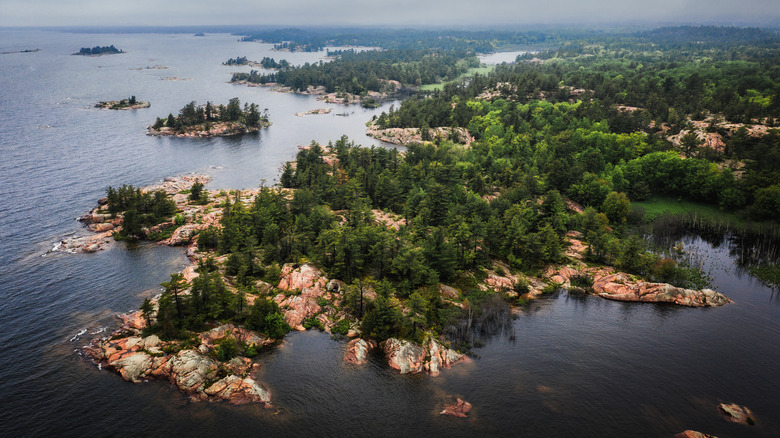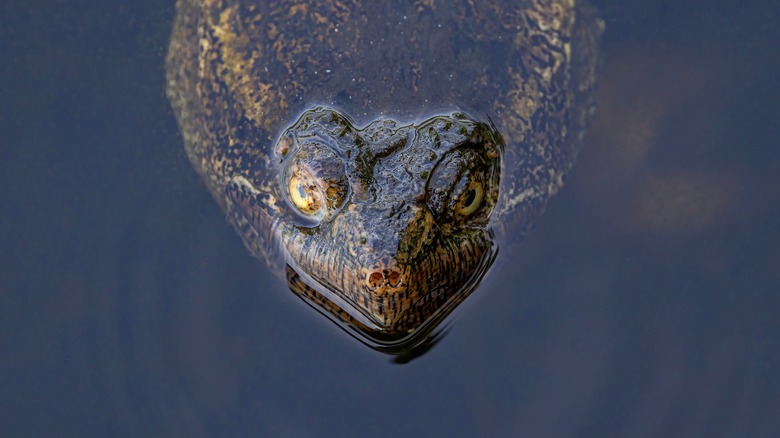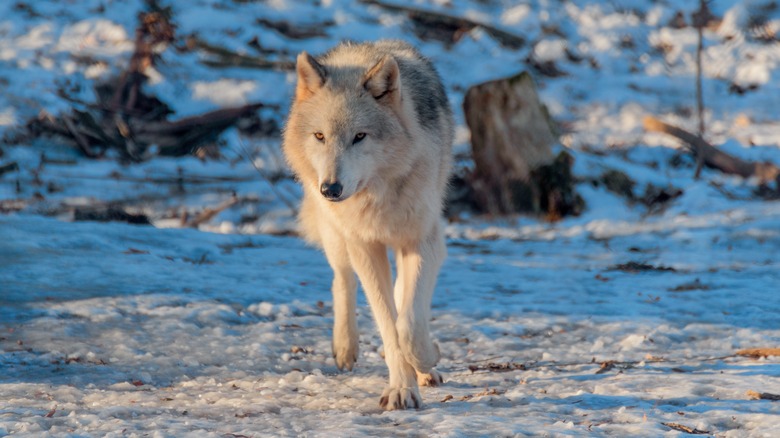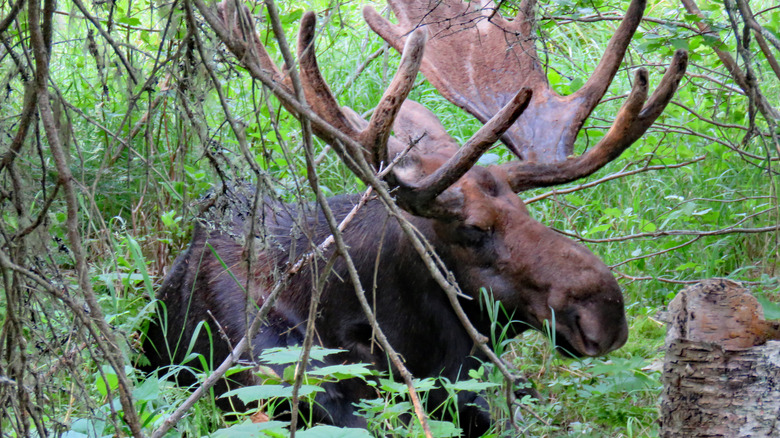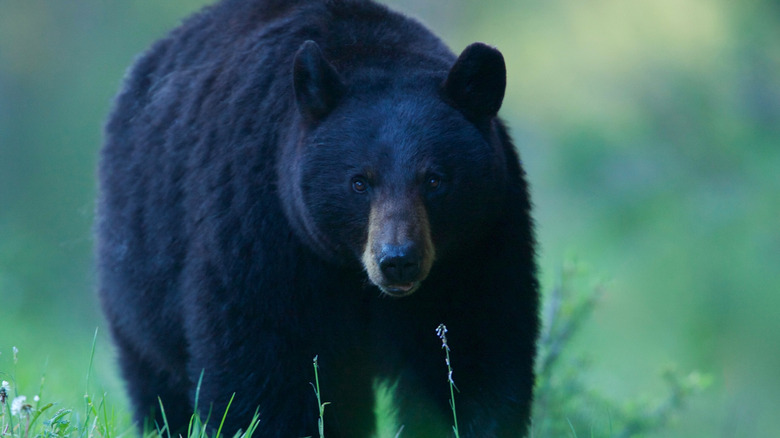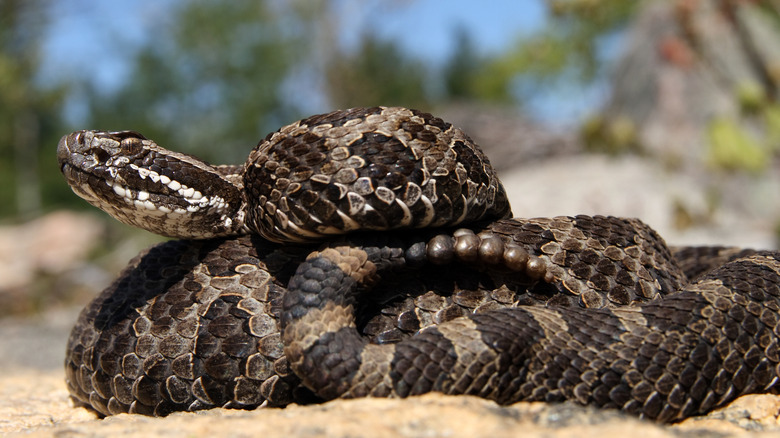5 Creatures To Beware Of When Adventuring In The Great Lakes Region
With a combined surface area of over 95,000 square miles, the five interconnected Great Lakes are considered the largest body of freshwater in the entire world. Sandwiched between the United States and Canada, the lakes — Erie, Huron, Michigan, Ontario, and Superior — are bordered by eight U.S. states, as well as the Canadian province of Ontario. Not only is the Great Lakes region vast in size, it is stunningly beautiful, frequently mentioned as a road trip bucket list destination as well as one of the most breathtaking places to camp in the United States.
As aesthetically pleasing as they may be, the lakes can also be deadly. These waters are susceptible to outbreaks of toxic blue-green algae and the frequently hostile water conditions make it quite dangerous to swim in some areas of the lakes. Additionally, the lakes and surrounding territory are also home to a vast array of marine creatures, fish, birds, and wildlife. While some of these creatures, such as the infamous sea lamprey, look sinister, they actually do not pose a threat to humans. However, although the majority of the wildlife living in the region are benign, there are a handful of creatures to beware of when adventuring in the Great Lakes region.
Snapping turtles will strike if threatened
The waters of the Great Lakes are home to a variety of fish and reptiles. Menacing-looking species such as sturgeon, northern pike, and muskellunge swim through the depths, but present little danger to humans. Sturgeon, for example, can grow to an intimidating eight-feet long. However, they have no teeth and, despite their size, feed along the bottom for insects and larvae. Pike and muskellunge, on the other hand, have incredibly sharp teeth. However, while there are documented cases of bites from these fish, such an incident is extremely rare. Rather, the biting creature adventurers should be most concerned about is the snapping turtle.
Snapping turtles are considered the most dangerous type of turtle and actually may be encountered on land or in the water. While they do not purposely seek to attack humans, they will strike if they feel threatened. This can easily happen if a swimmer steps on or accidentally puts their hands in front of an unseen turtle. Humans are also often bitten when attempting to handle snapping turtles. They have bite force sufficient enough to break bones or snap a finger and can use their neck nearly the length of their body to strike. So, if you do happen to encounter one, it is best to give it a wide berth and not attempt to pick it up or handle it for any reason.
Gray wolves have rebounded in the Great Lakes region
Although their historic range includes the entire Great Lakes region, gray wolves had been extirpated from the majority of this territory by the mid-1900s. However, thanks to a variety of conservation efforts, the gray wolf population is on the rebound. Several states in the western and midwestern portions of the U.S. have seen dramatic increases in wolf populations over the past few years. However, none have been quite as successful as the trifecta of Great Lakes states, as the wolf numbers in Wisconsin, Michigan, and Minnesota now represent the largest wolf population in the United States and the number of wolves in these states continues to grow.
Although the gray wolf, which is sometimes referred to as a timber wolf, is considered the most dangerous type of wolf in the world, humans can typically avoid negative encounters with them by taking proper precautions. Considering the high population of these feral canines found in the western portion of the Great Lakes region, it is important to know what to do if you run into a wolf and how to keep wolves away from your campsite when adventuring in this area. Additionally, any wolf sightings or encounters should be promptly reported to wildlife authorities.
Moose may be more dangerous than you realize
Moose are one of the more majestic creatures found in North America. They are the largest representative of the deer family, reaching heights upwards of seven feet and weighing well over 1,000 pounds. Additionally, mature males –- bull moose –- are adorned with impressive racks of antlers. While they appear docile and stoic, moose can be more dangerous than most people realize. In fact, in many areas moose are considered a bigger threat than bears. One reason for this is the fact moose are more commonly encountered than bears. Additionally, because many people do not realize the risk they pose, they often approach moose much closer than they should. Invading a moose's space is perhaps the most common way of provoking an attack.
With that in mind, the best thing to ensure safety when you come across a moose is to give it plenty of space and just observe from a distance. Never attempt to get closer in order to get a photo or try to feed a moose. If a moose does come at you, try to run to a building, vehicle, up onto an elevated position well above the moose's reach. More often than not, moose will not chase far –- they are just trying to push a perceived threat away from the vicinity. Additionally, be aware that moose are more likely to be aggressive during fall, when they are mating, and spring, when they are protecting young calves.
The black bear population is booming in Great Lakes states
Like the gray wolf, black bears once roamed throughout the entire Great Lakes region, but were extirpated from much of the territory in the last century. However, just as the wolf population is rebounding, the number of black bears has been growing as well. Today, all but two of the eight Great Lakes states have an established black bear population, with significant numbers of bears inhabiting Minnesota, Michigan, Wisconsin, Pennsylvania, and New York.
While the surging population is a conservation success story, black bears are one of the most dangerous types of bears. So, anyone adventuring in the Great Lakes region should be aware of what to do if they see or are attacked by a bear. The easiest things to do are be aware of your surroundings and make noise to avoid bears during your outdoor activities such as hiking. If you encounter a bear, don't run. Give it plenty of space and begin slowly making your way out of the area while keeping an eye on the animal to look for bear attack warning signs. Carrying and knowing how to use bear spray is a good precaution when adventuring in this region. If a black bear does attack, use the spray if you have it. If it continues to attack, fight back with everything you have and use anything you can get your hands on as a weapon.
Rattlesnakes represent a dangerous threat
The eastern massasauga rattlesnake is small when compared to other rattlesnakes, but still presents a potential danger to those exploring the Great Lakes region. It is found in every Great Lakes state as well as Ontario, Canada. So, for those who are adventuring on either side of the border in this region need to be aware of this dangerous type of snake. The good news for those spending time outdoors around the Great Lakes is the eastern massasauga rattlesnake is considered timid and prefers to stay hidden beneath leaves. Additionally, it is the only venomous snake found in several Great Lakes states such as Michigan. The slightly larger and more aggressive timber rattlesnake is present in several states in the region. In most of these states, the timber rattlers are restricted to the southern reaches, but there are populations established along the lakes in Ohio and New York.
Essentially, regardless of which state or province along the Great Lakes you happen to be exploring, odds are there will be at least one type of rattlesnake present. So, when striking out on an adventure in this region, it is important to know how to tell if a snake is venomous and what to do if you run into a rattlesnake. Staying safe mostly involves watching where you step and what you grab so as not to disturb a hiding rattler. It is also important to know what to do if bitten by a snake.
